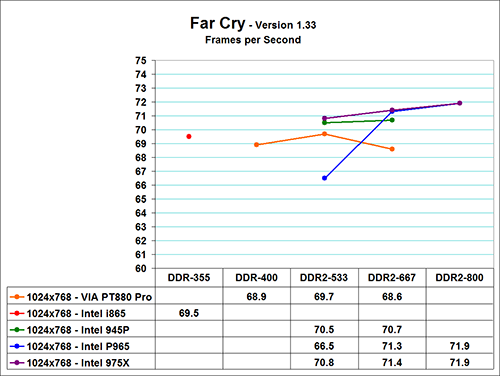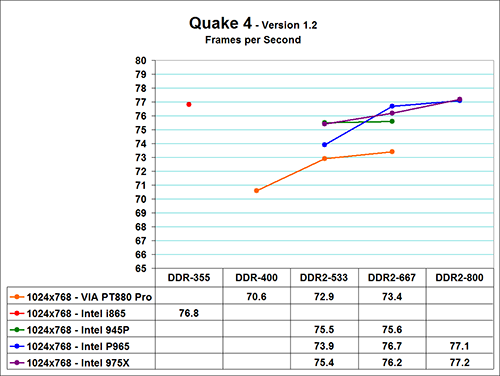Intel Core 2 Duo: Memory Performance Part Deux
by Gary Key on August 14, 2006 4:15 AM EST- Posted in
- Motherboards
Game Performance Comparison
While Sandra and Super Pi provided useful information on how memory performs without the influence of other components, our first round of real world tests has shown there is not a large difference in performance between DDR2 and DDR memory nor between DDR2-533 and DDR2-800. However, our next set of real-world benchmarks consists of gaming benchmarks. Due to the amount of information and the relative closeness of the scores we are not utilizing zero based charts as the line graphs would stack on each other. Although the data chart tells the story we felt like there should be some separation in the line graphs to accurately depict the information.
We utilize Far Cry, Half Life 2 and Quake 4 in our normal memory testing because they are sensitive to memory changes. We are adding Prey and Serious Sam II to our benchmark mix because they are typically very GPU dependent and we will see the effects of our memory choices on these games.
We originally tested at both 1024x768 and 1280x1024 resolutions at High Quality settings without anti-aliasing or antistrophic filtering enabled. However, we found at 1280x1024 that our results were basically GPU limited. We are only showing 1024x768 results as this resolution is not completely GPU limited with our 7600GS video card. We feel like our 1280x1024 and 1024x768 settings are representative of an i865/945P/VIA PT880 platform and believe most users at this price point would be utilizing a 17" or 19" monitor with this configuration. We will report 1280x1024 settings in our AGP versus PCI Express article.



Our three memory sensitive games show a pattern with the Biostar P965 board performing below average at DDR2-533 and then placing in the top section in the DRR2-667 and DDR2-800 results. The P965 results at DDR2-533 are opposite of our synthetic and application benchmarks. It appears the chipset timings are relaxed at this setting and this is affecting our game performance where memory sensitivity is important.
Our i865 based motherboard with the 7600GS AGP card is very competitive with the DDR2 board solutions and pulls away from the VIA PT880 Pro chipset in Quake 4 while performing equally at the VIA DDR2-533 settings. Although AGP is basically dead and the most powerful card available is based on the 7800GS chipset, we can see that it is still a very competitive solution in the mid-range market as is low latency DDR memory with the right chipset.
While Sandra and Super Pi provided useful information on how memory performs without the influence of other components, our first round of real world tests has shown there is not a large difference in performance between DDR2 and DDR memory nor between DDR2-533 and DDR2-800. However, our next set of real-world benchmarks consists of gaming benchmarks. Due to the amount of information and the relative closeness of the scores we are not utilizing zero based charts as the line graphs would stack on each other. Although the data chart tells the story we felt like there should be some separation in the line graphs to accurately depict the information.
We utilize Far Cry, Half Life 2 and Quake 4 in our normal memory testing because they are sensitive to memory changes. We are adding Prey and Serious Sam II to our benchmark mix because they are typically very GPU dependent and we will see the effects of our memory choices on these games.
We originally tested at both 1024x768 and 1280x1024 resolutions at High Quality settings without anti-aliasing or antistrophic filtering enabled. However, we found at 1280x1024 that our results were basically GPU limited. We are only showing 1024x768 results as this resolution is not completely GPU limited with our 7600GS video card. We feel like our 1280x1024 and 1024x768 settings are representative of an i865/945P/VIA PT880 platform and believe most users at this price point would be utilizing a 17" or 19" monitor with this configuration. We will report 1280x1024 settings in our AGP versus PCI Express article.



Our three memory sensitive games show a pattern with the Biostar P965 board performing below average at DDR2-533 and then placing in the top section in the DRR2-667 and DDR2-800 results. The P965 results at DDR2-533 are opposite of our synthetic and application benchmarks. It appears the chipset timings are relaxed at this setting and this is affecting our game performance where memory sensitivity is important.
Our i865 based motherboard with the 7600GS AGP card is very competitive with the DDR2 board solutions and pulls away from the VIA PT880 Pro chipset in Quake 4 while performing equally at the VIA DDR2-533 settings. Although AGP is basically dead and the most powerful card available is based on the 7800GS chipset, we can see that it is still a very competitive solution in the mid-range market as is low latency DDR memory with the right chipset.










34 Comments
View All Comments
Questar - Monday, August 14, 2006 - link
Buy the cheapest memory you can find and spend the money you save somewhere else.deathwalker - Monday, August 14, 2006 - link
This does seem to validate from a cost vs. performance basis this motherboard..however I remain a tad sqeemish about making a platform jump from AMD to Intel using this board. Having said that though, if you are on a tight budget and you have to migrate parts I suppose giving this board a shot isn't a bad idea.Gary Key - Monday, August 14, 2006 - link
We will be reviewing some value/budget AMD AM2 combo motherboards in the future so the idea of incrementally upgrading to the newer platform from early S754/939 still holds true to a certain degree.
blppt - Monday, August 14, 2006 - link
On page 6..."Although AGP is basically dead and the most powerful card available is based on the 7800GS chipset, we can see that it is still a very competitive solution in the mid-range market as is low latency DDR memory with the right chipset."
What about the limited edition Gainward 7876 BLISS, which is supposedly actually based on the 7900GT? Thats considerably more powerful than a regular 7800GS.
http://www.gainward.net/products/product.php?produ...">BLISS
Last I checked, overlockers uk still had them in stock. Although at ~$445 american, you'd wonder if its worth it, or just upgrade to an X2 and PCI-E mobo instead.
Gary Key - Monday, August 14, 2006 - link
I have an inquiry into Gainward about the actual core used on this card. They still advertise it as a 7800GS based unit. Yes, it is very expensive when you can upgrade your CPU, motherboard, and memory for about the same price.blppt - Monday, August 14, 2006 - link
Yeah, they advertise it like that, but its a 24 pipe card clocked at 450/1250, which seems to be somewhere between a 7800GT and a 7900GT.poohbear - Monday, August 14, 2006 - link
"Who knew that AGP 8x and DDR would still be this competitive after a myriad of chipset, memory, CPU, and GPU enhancements over the last three years?"i thought it was pretty settled that the move from agp 8x was introduced for 1.) marketing reasons so ppl actually buy new chipsets we dont need and 2.) so nvidia could make some extra cash off their SLI gig. the bandwidth agp 8x provided was never saturated. great article nonetheless showing that value boards are still a nice option (i own the Asrock Dualsata2, great mobo btw after they fixed the 274htt cap).
on a sidenote i love the part "deux" in the title, we're so international @ anandtech aint we.;) or maybe u're just canadian, hafta include some french in everything.:p
bob661 - Monday, August 14, 2006 - link
I guess ATI doesn't count, huh? Also, would AGP provide the bandwidth necessary for SLI and Xfire setups? People keep making these sweeping "we don't need PCIe" statements without knowing or stating all of the factors involved.Kiijibari - Tuesday, August 15, 2006 - link
Have you red the last AGP 3.0 Specification ? If not look here at p. 115 / 5.2.3:http://members.datafast.net.au/dft0802/specs/agp30...">http://members.datafast.net.au/dft0802/specs/agp30...
In Short: Multiple video cards are possible with AGP 3.0 :)
cheers
Kiijibari
Gary Key - Monday, August 14, 2006 - link
I added my sarcastic comment notation at the end of the statement. ;-) While PCI Express is certainly a welcome technology and will be viable for a long time (in computer terms), it was introduced too early and abruptly in my opinion. Except for SLI/CrossFire type setups, there was no real "engineering" requirement for it on the desktop until recently. Yes, there is a French/Canadian influence in the household. :)